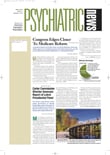For five years now, evidence has been building that stimulation of the left vagus nerve can counter treatment-resistant depression.
Stimulation is carried out with an implantable device called the NeuroCybernetic Prosthesis (NCP) system, which is similar to a cardiac pacemaker. The device was developed by the Houston-based company Cyberonics.
In 1998, for example, A. John Rush, M.D., a professor of psychiatry at the University of Texas Southwestern Medical Center; Mark George, M.D., a professor of psychiatry and neurology at the Medical University of South Carolina; Lauren Marangell, M.D., an associate professor of psychiatry at Baylor College of Medicine; and Harold Sackheim, Ph.D., of the New York State Psychiatric Institute started to use the NCP system to stimulate the left vagus nerve of 30 subjects who were suffering from serious, treatment-resistant depression and who had not been helped by therapies such as antidepressants or even electroconvulsive therapy. The subjects received stimulation for a 10-week period, and 40 percent of them experienced a lessening of depression following stimulation (Psychiatric News, January 21, 2000).
These investigators then used the NCP system to stimulate the left vagus nerve of not just these 30 subjects, but also of 30 more with treatment-resistant depression and followed their outcomes for two years. Some 30 percent of the 60 subjects experienced a substantial reduction in depression; 15 percent had their depression lift altogether (Psychiatric News, August 17, 2001).
And now Rush, George, and Marangell, along with a number of other investigators in North America, have conducted two large clinical trials that further underscore the value of NCP System stimulation of the left vagus nerve for countering treatment-resistant depression. Specifically, Rush was the lead investigator in the trial conducted at 21 sites in which 205 subjects with treatment-resistant depression received, for a year, both their usual care and the left vagus nerve stimulation.
The other trial was conducted at 13 sites, and 124 subjects with treatment-resistant depression received, for a year, only care as usual—that is, served as controls. At the end of the year, outcomes for both groups were assessed and compared. Cyberonics publicized the preliminary results in a July 23 press release.
The one-year response rate, defined as at least a 50 percent improvement in depression symptoms and measured by the Inventory of Depressive Symptomatology–Self Report, was 21 percent in the group that got vagus nerve stimulation and usual care, compared with 12 percent in the control group. The one-year response rate measured by the clinician-rated Hamilton Rating Scale for Depression was 30 percent for the group that got vagus nerve stimulation and usual care, compared with 13 percent for the control group.
Further, the percentage of subjects free of depressive symptoms after one year of treatment was 16 percent in the vagus nerve stimulation group, compared with 5 percent in the control group as measured by the Inventory of Depressive Symptomatology-Self Report, and 17 percent in the vagus nerve stimulation group, compared with 7 percent as measured by the Hamilton Rating Scale for Depression.
Finally, improvements found in the vagus nerve stimulation group at one year, as compared with baseline, were statistically and clinically significant, the researchers reported.
In light of these results, some proponents of the NCP System are wondering when the U.S. Food and Drug Administration (FDA) might approve the system for treating treatment-resistant depression—it has been approved for treating epilepsy since 1997.
“That is the question everyone wants to answer, including us,” Richard Rudolph, M.D., vice president of clinical and medical affairs and chief medical officer of Cyberonics, told Psychiatric News. “However, I can say that we plan to make a submission [to the FDA] with these new data by the end of October. . . . It is really then in their hands.”
In fact, if vagus nerve stimulation as a means of treating recalcitrant depression is ever going to become clinically available in the United States, it looks as though it is going to be via the NCP System, since the company’s patents “preclude anyone else from using this particular approach to treating depression,” Randolph said. ▪
